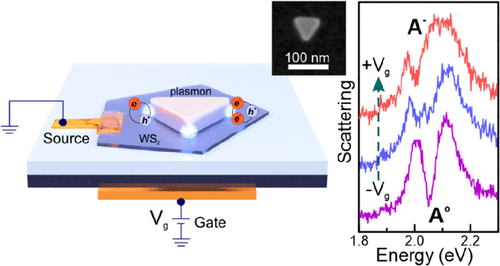Our official English website, www.x-mol.net, welcomes your feedback! (Note: you will need to create a separate account there.)
Electrical Control of Hybrid Monolayer Tungsten Disulfide-Plasmonic Nanoantenna Light-Matter States at Cryogenic and Room Temperatures.
ACS Nano ( IF 17.1 ) Pub Date : 2020-01-10 , DOI: 10.1021/acsnano.9b09684 Battulga Munkhbat 1 , Denis G Baranov 1 , Ankit Bisht 1 , Md Anamul Hoque 2 , Bogdan Karpiak 2 , Saroj P Dash 2 , Timur Shegai 1
ACS Nano ( IF 17.1 ) Pub Date : 2020-01-10 , DOI: 10.1021/acsnano.9b09684 Battulga Munkhbat 1 , Denis G Baranov 1 , Ankit Bisht 1 , Md Anamul Hoque 2 , Bogdan Karpiak 2 , Saroj P Dash 2 , Timur Shegai 1
Affiliation

|
Hybrid light-matter states-polaritons-have attracted considerable scientific interest recently, motivated by their potential for development of nonlinear and quantum optical schemes. To realize such states, monolayer transition metal dichalcogenides (TMDCs) have been widely employed as excitonic materials. In addition to neutral excitons, TMDCs host charged excitons, which enables active tuning of hybrid light-matter states by electrical means. Although several reports demonstrated charged exciton-polaritons in various systems, the full-range interaction control attainable at room temperature has not been realized. Here, we demonstrate electrically tunable charged exciton-plasmon polaritons in a hybrid tungsten disulfide (WS2) monolayer-plasmonic nanoantenna system. We show that electrical gating of monolayer WS2 allows tuning the oscillator strengths of neutral and charged excitons not only at cryogenic but also at room temperature, both at vacuum and atmospheric pressure. Such electrical control enables a full-range tunable switching from strong neutral exciton-plasmon coupling to strong charged exciton-plasmon coupling. Our experimental findings allow discussing beneficial and limiting factors of charged exciton-plasmon polaritons, as well as offer routes toward realization of charged polaritonic devices at ambient conditions.
中文翻译:

低温和室温下混合单层二硫化钨-肺纳米纳米天线光态的电控制。
混合光物质状态-极化子由于其发展非线性和量子光学方案的潜力,最近引起了相当大的科学兴趣。为了实现这样的状态,单层过渡金属二硫化碳(TMDC)已被广泛用作激子材料。除中性激子外,TMDC还可以容纳带电激子,从而可以通过电学方法主动调整混合光物质的状态。尽管一些报道表明在各种系统中带电的激子-极化子,但在室温下仍无法实现全范围的相互作用控制。在这里,我们展示了混合二硫化钨(WS2)单层-等离激元纳米天线系统中的电可调激子-等离激元极化子。我们表明,单层WS2的电门控不仅可以调节中性和带电激子的振荡器强度,不仅可以在低温下,而且还可以在室温下(在真空和大气压下)进行调节。这种电气控制可实现从强中性激子-等离子体耦合到强电荷激子-等离子体耦合的全范围可调切换。我们的实验发现允许讨论带电激子-等离子体激元极化子的有益和限制因素,并提供在环境条件下实现带电极化子设备的途径。
更新日期:2020-01-10
中文翻译:

低温和室温下混合单层二硫化钨-肺纳米纳米天线光态的电控制。
混合光物质状态-极化子由于其发展非线性和量子光学方案的潜力,最近引起了相当大的科学兴趣。为了实现这样的状态,单层过渡金属二硫化碳(TMDC)已被广泛用作激子材料。除中性激子外,TMDC还可以容纳带电激子,从而可以通过电学方法主动调整混合光物质的状态。尽管一些报道表明在各种系统中带电的激子-极化子,但在室温下仍无法实现全范围的相互作用控制。在这里,我们展示了混合二硫化钨(WS2)单层-等离激元纳米天线系统中的电可调激子-等离激元极化子。我们表明,单层WS2的电门控不仅可以调节中性和带电激子的振荡器强度,不仅可以在低温下,而且还可以在室温下(在真空和大气压下)进行调节。这种电气控制可实现从强中性激子-等离子体耦合到强电荷激子-等离子体耦合的全范围可调切换。我们的实验发现允许讨论带电激子-等离子体激元极化子的有益和限制因素,并提供在环境条件下实现带电极化子设备的途径。


























 京公网安备 11010802027423号
京公网安备 11010802027423号